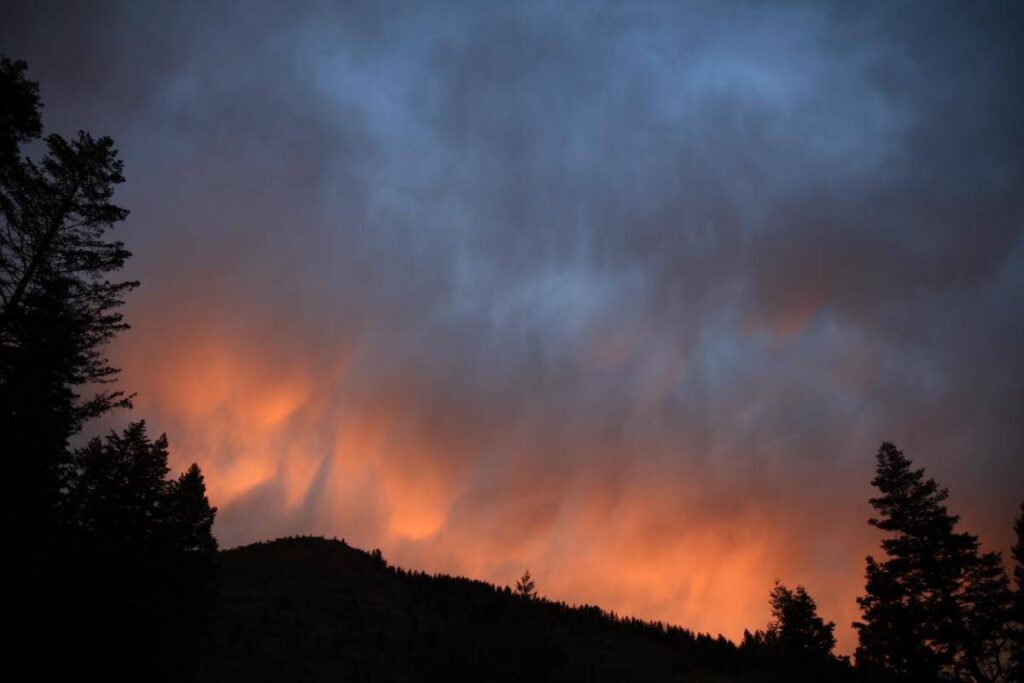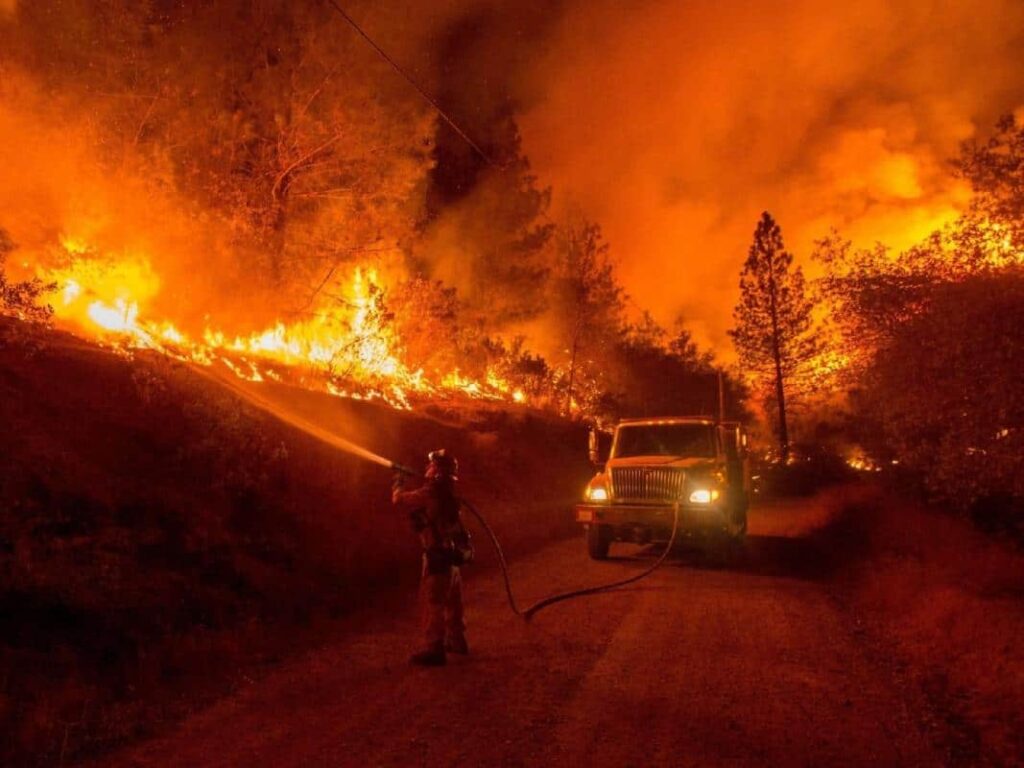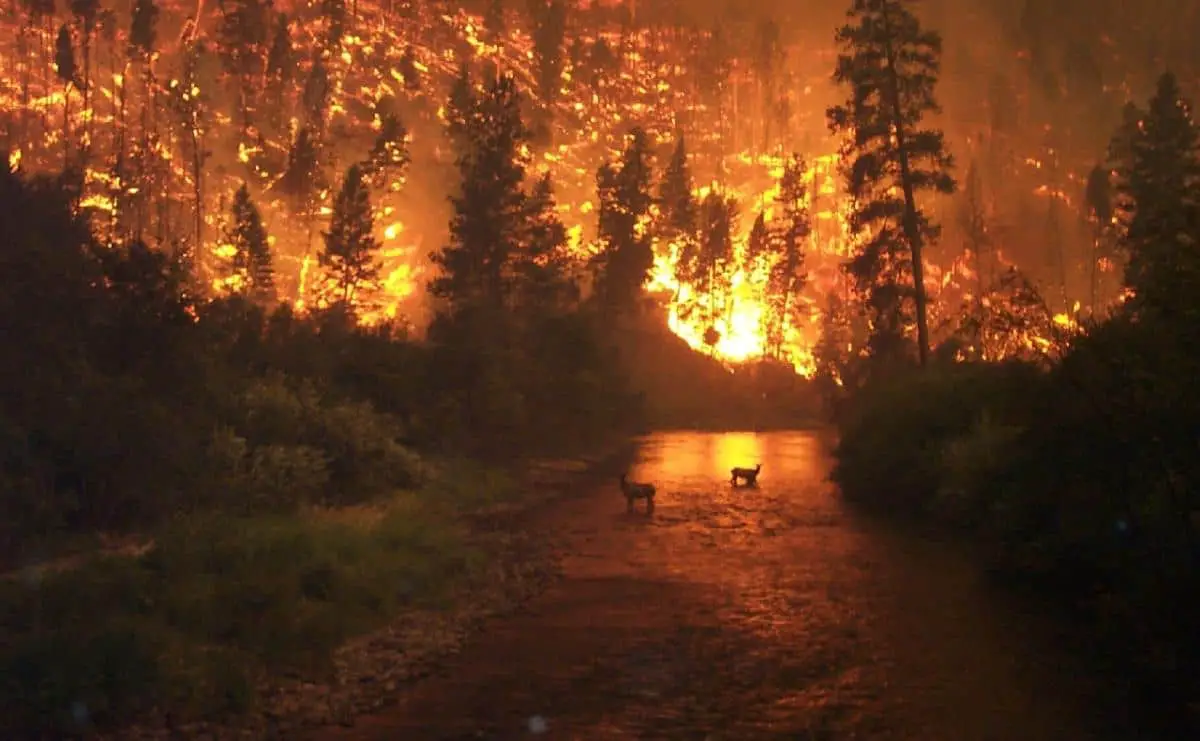Due to global heating, wildfires around the globe are on the rise. This natural phenomenon poses an increasing threat to Banff National Park as well. But don’t worry, Parks Canada does everything it can to contain and limit these infernos to the public’s safety and preserve the park. In this post, you’ll read about how they occur and what will happen when a wildfire threatens the park during your stay.
First off, let me give you some peace of mind: The chance you will witness a wildfire during your time in Banff National Park is very small. Since the turn of the century, only four years saw non-prescribed forest fires in Banff.
Okay, let’s have a look at the things you want to know.
Are Banff and Lake Louise at Risk of Wildfires?
The inconvenient answer to this question is yes, they are. This has everything to do with the location of Banff and Lake Louise.
Both are situated in the middle of the Rocky Mountains, surrounded by countless trees of an old-growth forest. Moreover, wildfires in the park occur every year, somewhere in the park. Parks Canada and the local fire departments do everything to limit the possibility of a wildfire reaching residential areas.
If you see a wildfire, report it to Banff Emergency Dispatch at +1 403 – 762 4506.
What in Case of a Wildfire During Your Trip?
If a forest fire occurs near residential areas in the park (mainly the town of Banff and Lake Louise), you will need to be ready to get evacuated. Have a go-bag prepared with clothing, important documents and medication.
This is also the case when the risk of wildfires is labeled ‘extreme’, generally due to lengthy periods of drought and high temperatures.
It may happen. As recently as July 2021, the town of Banff handed out evacuation plans to homeowners and visitors with instructions on what to do in case of a wildfire.
Besides the immediate danger a forest fire poses to people and animals, other, less apparent risks make evacuation necessary. In the case of a forest fire in the park, smoke can travel many miles and keep lingering in the air for weeks.
The fire throws large quantities of finer particulates and nanoparticulates into the air. These can penetrate the lung membranes and are, therefore, harmful to human health as they can damage the respiratory system and pass into the bloodstream.
According to the American Lung Association, these particulates may lead to coughing, shortness of breath and exacerbated asthma attacks.

What Causes Banff Wildfires?
A wildfire often occurs due to natural causes, most likely by lightning activity in the area. Another main cause is human activity, like abandoned campfires that weren’t put out properly.
There are also prescribed forest fires conducted by Parks Canada. These fires have an ecological function. For more information on this subject, see the paragraph under the subheading Why does Parks Canada Conduct Forest Fires?
When Do Wildfires Occur in Banff?
A set period during the year is prone to wildfires in the park.
The Banff wildfire season lasts from March through October. During this period, temperatures are at their highest and precipitation is at its lowest. This creates ideal circumstances for wildfires as the dried-out landscape vegetation acts as a natural fuel source.
Wildfires are most likely to occur in July and August, though the official season now starts as early as March. This used to be April, but it was moved to one month earlier due to global warming.
It means that the wildfire season is getting longer. Also, it can occur in more places than before.
Besides more extended periods of drought, a wildfire needs particular weather to occur. Hot, dry and windy weather are the best circumstance for these fires to develop.
How Often Do Wildfires Occur in Banff?
Around the time the park was established (1885), wildfires were frequent in the Rocky Mountains. However, despite climate change, the number of wildfires and the area burned in Banff National Park have decreased dramatically over the decades.
Since 1880, most of the park’s wildfires have been started by man, one way or the other. Parks Canada does everything to educate the park’s visitors on how to prevent a wildfire and make campsites safe, especially regarding (the use of) fire pits.
Why Does Parks Canada Conduct Forest Fires?
Wildfires are hazardous and seemingly hard to contain, yet Parks Canada regularly conducts fires in the park. These are so-called prescribed fires. This is necessary to ‘balance the ecological role of fire with the risks it poses’, as is written on the Parks Canada website.
It reduces the risk wildfires pose to residents and the communities in the park. It also helps restore the biodiversity and health of the park’s forests and grasslands and reduces the build-up of fire fuels which could cause significant wildfires.
Conducting prescribed wildfires in the park has been common practice since 1983. Back then, Banff was the first national park in Canada to do so.
Three years earlier, the fire management planning project was installed. This project aimed to ‘determine the ecological function of fire in BNP ecosystems and to implement a plan to restore fire to its natural role’, as is stated in the report Wildland Fires in Banff National Park 1880-1980 by Cliff White.
Prescribed fires in the park need to meet strict measurements. According to Parks Canada, they can only be conducted ‘when predetermined weather and site conditions are met’.
Since the 1983 introduction of prescribed wildfires in Banff National Park, these fires have been conducted almost every year. According to Sean Coogan et al. (2020), in 1995-1997 and 2011, 2013 and 2017, there were no prescribed wildfires in the park.
How Is a Wildfire Beneficial to the Park?
It sounds like a contradiction, a wildfire benefitting a forest, because of its destructive nature. The opposite is true.
Wildfires benefit plant communities’ ecology and evolution because they burn off low-growing underbrush, clear the forest floor of trash, expose the area to sunlight, and nourish the soil. Existing (untouched) trees also profit from wildfires. They can get stronger and healthier as the fire has reduced resource competition.
Research has shown that if it weren’t for these prescribed fires, forests without wildfires would have a less diverse habitat and would be almore prone to diseases and (the harmful influence of) insects. In other words: Wildfires are a catalyst for new life in the park.

What Does Climate Change Have to Do with Wildfires in Banff?
Because of global warming, temperature averages increase and record highs are broken regularly. This has resulted in the wildfire season starting earlier and lasting longer. Moreover, the risk of wildfires is more often set to ‘extreme’.
Research by Flannigan et al. (2005) shows that ‘studies of the potential impacts of climate change on the area burned in North America’s boreal forest have projected increased disturbance levels through the current century’.
In 2003, 2009, 2014 and 2015, spontaneous (non-prescribed) wildfires occurred in Banff National Park. The 2014 wildfire was by far the most significant, burning approximately 2,200 hectares. The wildfire of 2003 was the first non-prescribed wildfire since 1968 (!). Furthermore, 2019 saw a record-breaking 885,943 hectares of burned land due to wildfires in Alberta.
Let’s have a look at Banff’s hot weather records over the last ten years. We see that 2021, in particular, was a scorching year breaking long-standing temperature records day after day, sometimes by a considerable margin.
It broke records in June (38˚C / 100 ˚F) and July (37˚C / 99˚F). Three years earlier, the highest-ever temperature for August was recorded (34 ˚C / 93˚F).
Also, official Banff weather data shows that the average temperature has been upward for the last decades. This is evidenced by the graph you’ll find in the post Everything about Banff Weather: Average Rain, Snow & Temperatures, which is based on this data.
If we put this question in a historical perspective, it appears that, despite global warming, wildfires were much more common in the park’s early days.
Studies have shown that before 1880 wildfires in the park’s area (Banff National Park didn’t exist yet at that time) occurred relatively frequently. This happened mainly in lower-elevation forests because at higher altitudes, forests were less prone to wildfires due to cooler and moister conditions.
Many of the causes of these wildfires were human-caused, like the railroad construction through the Rocky Mountains, mining, highway slashing, timber operations and early land-use practices.
Nowadays, the fire fighting facilities in the park have drastically improved and prescribed wildfires also help (see the subheading Why Does Parks Canada Conduct Forest Fires?). Also, strict rules help prevent wildfire as a result of human activity.
Famous Wildfires in the Park
There have been many more wildfires over the past century and a half, though most of them were small. Striking is how the last big wildfire was in 1940.
Between this fire and 1983, when Parks Canada started prescribed wildfires, there was only one (!) wildfire in 1968. Since 1983 only four years saw non-prescribed wildfires. It is testament to how Parks Canada has controlled wildfires in the park, despite global heating.
Below you’ll find a table with the most significant wildfires in the park since 1881.
| YEAR | AREA BURNED | AREA | CAUSE |
|---|---|---|---|
| 1881 | 8,000 hectares | Lower Bow | Unknown |
| 1889 | 12,150 hectares | Lower Bow – Cascade River | Unkown |
| 1891 | 7,400 hectares | Lower Bow | Probably railroad construction |
| 1908 | 5,000 hectares | Castle Junction | Probably lightning |
| 1921 | 4,300 hectares | Around Red Deer River | Lightning |
| 1936 | 5,200 hectares | Flints Park | Recreation |
| 1940 | 4,000 hectares | Around Saskatchewan Crossing | Unknown |
The last big wildfire dates from September 4, 2020. An abandoned campfire near the Devils’ Head, bordering the park’s boundary, caused 2,420 hectares to get burned over ten months.
Selected Sources
- Cliff White, Wildland Fires in Banff National Park 1880 – 1980, Occasional Paper No. 3, National Parks Branch, Parks Canada, Environment Canada, 1985
- The American Lung Association
- Parks Canada
- Canadian National Fire Database
- National Forestry Database
- Coogan, Sean & Daniels, Lori & Boychuk, Den & Burton, Philip & Flannigan, Mike & Gauthier, Sylvie & Kafka, Victor & Park, Jane & Wotton, Mike. (2020). Fifty years of wildland fire science in Canada. Canadian Journal of Forest Research. 51. 10.1139/cjfr-2020-0314.


Thank you Dan for your love of the area and helping others to understand it and appreciate it.
I am traveling north through Montana very soon and I am concerned about the wildfires in Banff and Lake Louise area.
I also want to learn about camping facilities I drive a truck hauling a 24 foot Camper. Ideally, I would prefer a camping situation with full hook up but I can work with just electric and water.
Do you have any suggestions if I should stall my visit until after August or come ahead now as I hope to do.
I am a retired gal traveling alone with a small dog so I am seeking your advice and appreciate anything you can offer. It has been 25 years since I’ve been to Western Canada and I’m interesting in returning to Victoria Island as well.